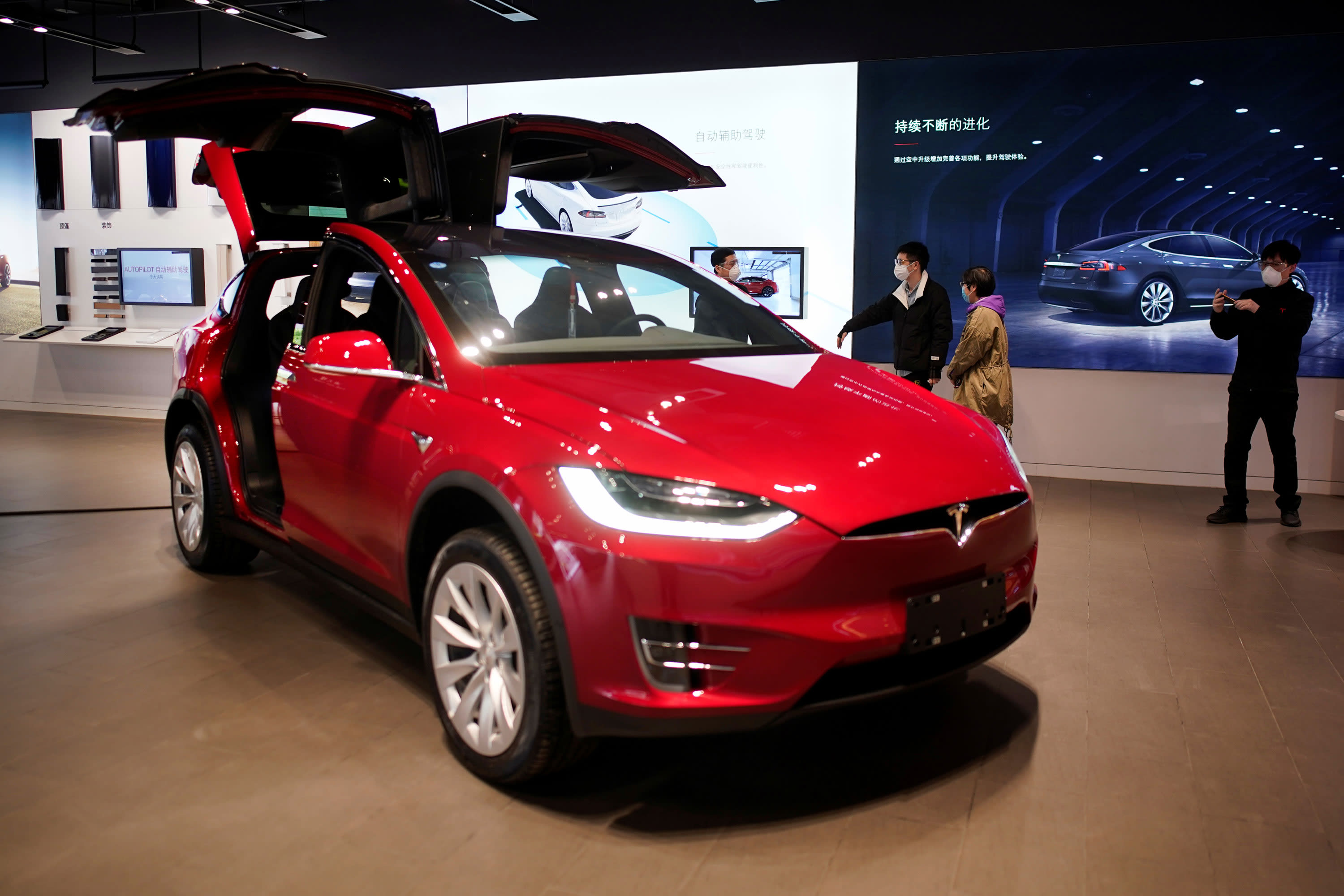People wearing face masks are seen inside a Tesla showroom at a shopping mall in Wuhan, Hubei province, the epicentre of China’s coronavirus disease (COVID-19) outbreak, March 30, 2020.
Aly Song | Reuters
Tesla’s entry into the S&P 500 could be anything but a quiet ride, and it is likely to put downward pressure on other stocks in the index temporarily.
Already, investors are gaming how its entry could impact the S&P 500, adding volatility and forcing the sale of other names in the index, as investors and funds that have to own the full index make room for Tesla.
The volatile stock has an unusually large market cap for a new member of the index – about $465 billion as of Wednesday, when not including founder Elon Musk’s 20% stake. With 17% of the value of the S&P in the hands of index investors, that means $80 billion worth of Tesla will have to be bought, according to S&P Dow Jones Indices senior index analyst Howard Silverblatt.
“Because the market cap is so enormous and the amount of dollars that are going to be needed to buy for the index people is so large, there’s a lot of stock for sale in the other 499 names of the S&P,” said Peter Boockvar, chief investment strategist at Bleakley Advisory Group.
S&P Dow Jones Indices is expected to announce the stock it is removing to make way for Tesla Friday after the market close, and Tesla will officially trade as a member of the S&P 500 on Dec. 21.
Tesla joins the S&P at next Friday’s closing price, a day expected to be volatile already because it is also the quadruple witching quarterly options expiration.
“The 18th is when all the action happens,” said Silverblatt. But he noted investors, other than the indexers, could be adding Tesla before that and trading the other names in the index.
The addition of Tesla will cause the largest rebalancing ever of the S&P 500. Silverblatt said Tesla could create more trading than many other names added to the index just simply because it has not been in the S&P 1500, as a member of the S&P 400 Midcap or S&P 600 Small Cap indices.
Often, companies leaving the S&P 500 will join the S&P 400 Midcap index, and many times companies graduate from the midcap index to the S&P 500 as they grow, Silverblatt said.
“When a company comes that’s not in the 1500, it gets a bigger hit. More institutions have to buy them . They are in the index for all U.S. stocks but they are not in the S&P small cap or midcap usually,” said Silverblatt.
Silverblatt said Tesla could be similar to the experience with Yahoo, when it was added. It was not a member of an S&P small or midcap index, and there was a lot of buying interest by institutions. Yahoo stock rose 50% between the announcement and its entry into the index, he said.
Funds managers that must buy the index will try to buy Tesla as near the Dec. 18 closing price as possible. “It’s probably going to be one of the biggest market on close buy orders of all time,” said Boockvar.
“I think the weighting is going to be 1.5% at the current market cap. The name it is replacing, you assume, has a lower allocation. Therefore Tesla has to take from the other 499, a little piece from each,” Boockvar said. Tesla is big, but it is still small compared to Apple, which is 6.4% of the S&P’s value, or Microsoft at 5.3%
Silverblatt said Tesla would be the seventh largest company in the S&P by market cap, after Apple, Microsoft, Amazon, Facebook, and Alphabet’s Class A and Class C shares. It is just ahead of Berkshire Hathaway.
Boockvar noted that Tesla is already up 15% since its inclusion in the S&P was announced Nov. 16, and it moved in a $60 or 10% trading range on Thursday alone. The company also announced this week it would raise up to $5 billion in a secondary share offering, its second in three months.
“Typically, the market cap of the company coming in isn’t even close to this. Usually it’s a few billion market cap. It’s rare to have a nine figure market cap company going into the S&P. Usually it’s already in the S&P at a smaller market cap. This has the potential of being much more volatile,” said Boockvar.
Tesla could keep adding volatility to the index, once it’s a member.
“It’s a wild fish in a big pond,” said Paul Hickey, co-founder of Bespoke. “It’s not going to change everything, but if you’re looking closely you’ll notice it. If you’re just driving by the pond, you wouldn’t notice it, but if you look underneath the surface of the pond, you’ll see this one crazy fish down there.”
Hickey said he expects to see some selling pressure on the other S&P names temporarily, ahead of Tesla’s entry. As for the stock that will leave the S&P to make room for Tesla, he said the exiting companies have had mixed performances.
But he noted that of the 15 stocks that joined the S&P 500 so far this year, most of them have outperformed the S&P since their inclusion. Just four have underperformed the S&P index since they joined it, and only one, DexCom is lower since it was added.
Carrier Global has performed the best of this year’s entrants and it is up more than 120%, outperforming the S&P by more than 75% since it was added April 3.
Source: Bespoke
